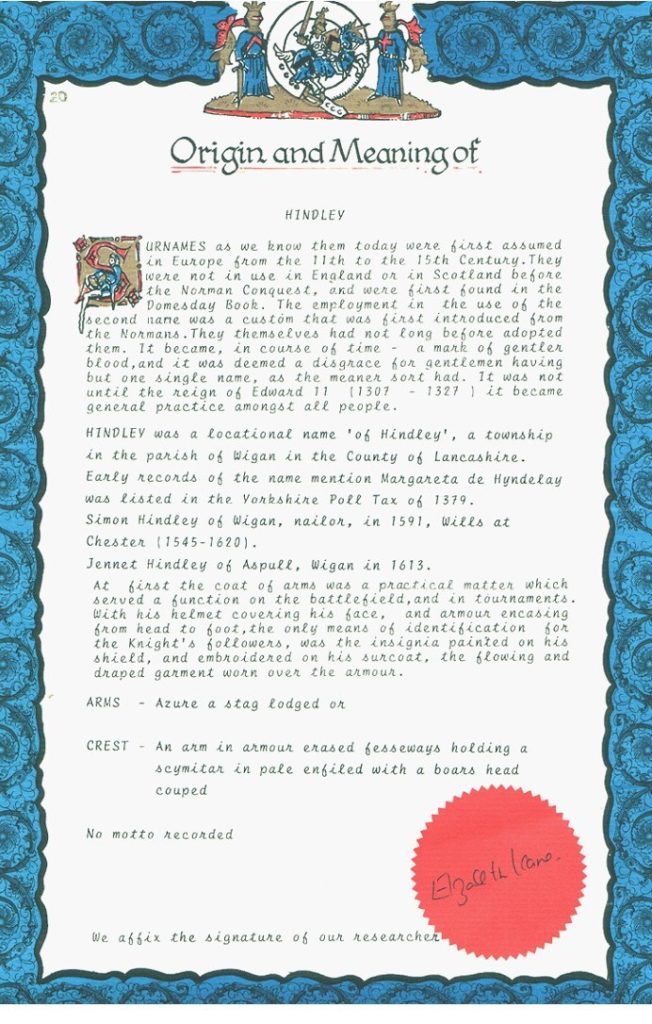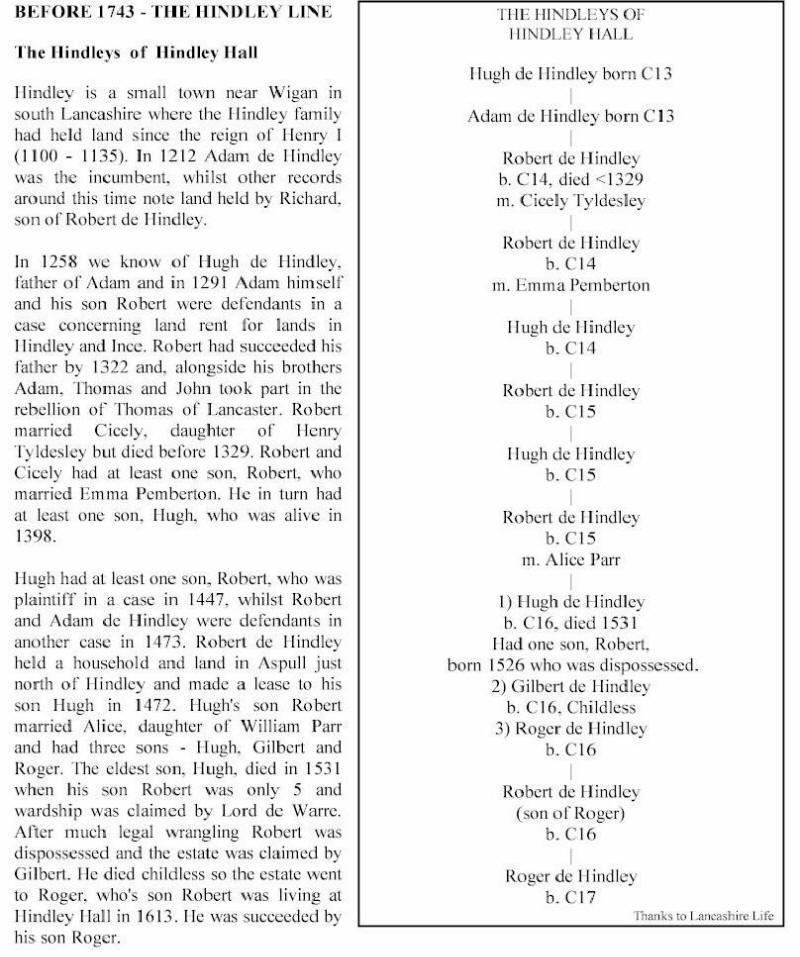History of the Hindley Family

Early Hindley Records
Other early Hindley references include:
John de Hyndelegh of Little Crosby and Thurstan de Hyndeley of Euxton, both in the Lancashire Lay Subsidy Rolls of 1332. Margareta de Hindley in the Yorkshire Poll Tax of 1379
Though the Hindleys were mostly confined to Lancashire until the end of the 18th century, there were outposts in Cheshire earlier. There are in fact entries in the Great Budworth records as early as the 1620s with William and Peter (Petrus) Hindley baptised 8/7/1621 and ?/2/1622 respectively, both sons of Randolph (Radulphi) Hindley.
The Cheshire and Lancashire Wills indexes for 1545 – 1620, 1681 – 1700 and 1761 – 1780 do not list any Hindleys in Cheshire, but 14, 9 and 6 respectively in Lancashire.
The real test is making a connection between the Lancashire based Hindleys and the generations of shoemakers in Cheshire which we know about beginning with George Hindley, born ~ 1743. Where the family lived before George moved into Great Budworth is the subject of current research. There are no signs of his baptism in the surrounding parishes despite the presence of Hindley families in Whitegate and Over parishes.
It is more likely that he moved to Great Budworth from across the Mersey in Lancashire; The only candidate listed in the IGI is a George Hindley born in Farnworth by Bolton in 1743.
The Hindleys of Over St Chad’s
One of two Hindley dynasties established in mid-Cheshire in the eighteenth century but probably not related to the Great Budworth one was that descended from John Hindley and Rebecca Dun who married at St Chad’s, Over on May 11th 1727. They had 8 children, all baptised at Over:
John (bapt. 19/9/1727) married Mary Nield 25/12/1755. Had 4 children:
John (bapt. 27/11/1756), married Mary Minshull, had a daughter Mebella bapt 13/9/1807.
Mary (bapt 19/9/1762)
Thomas (bapt. 7/9/1766)
Joseph (bapt. 20/12/1773)
Thomas (bapt. 10/5/1730)
Matthew (bapt. 10/2/1732). Had two daughters:
Jane (bapt. 11/3/1759)
Rebecca (bapt. 14/9/1766)
Jane (bapt. 1/1/1735)
Elizabeth (bapt. 3/12/1736)
George (bapt 26/2/1741) married Jane Green 24/11/1766 at Over, had 6 children:
John (bapt. 9/8/1767)
Thomas (bapt. 30/7/1769)
Hannah (bapt. 8/9/1771)
Susannah (bapt. 24/3/1776)
Sophia (bapt. 12/10/1777)
Sarah (bapt. 23/4/1780)
Charles (bapt. 14/10/1744)
Thomas (bapt. 5/5/1749)

THE PARISH OF GREAT BUDWORTH by D.Jowitt
One of the great Ancient Parishes of Cheshire, Great Budworth extends some 8 miles from Appleton township in the north down to Barnton in the south, and 12 miles from Dutton in the west to Tabley Inferior, the most eastern township. Straddling the border of the Hundreds of Bucklow and Northwich, the parish contains some 21 townships; Anderton, Antrobus, Appleton, Aston by Budworth, Barnton, Bartington, Cogshall, Comberbach, Crowley, Dutton, Great Budworth, Higher (Over) Whitley (technically a Lordship containing the townships of Antrobus, Crowley, Sevenoaks, Over Whitley and Cogshall), Little Leigh (chapelry), Lower (Nether) Whitley (chapelry), Marbury, Marston, Pickmere, Seven Oaks, Stretton, Tabley Inferior and Wincham.
Budworth means “dwelling by the water”, the Great prefix differentiates the parish from the nearby parish of Little Budworth. The Domesday Book mentions a priest of Great Budworth suggesting there was a church on the site in 1086, but there is no record of a church in the book. Before the dissolution the church was under the care of the Augustinian Canons of Norton, afterwards the tithes were passed on to Henry VIII’s new College of Christ Church, Oxford.
Great Budworth has a history of religious radicalism which is entwined with the story of Mary’s ancestors, particularly the Gandy line. With a long line of Puritan ministers from the beginning of the 17th century, most notably John Ley (vicar 1616 – 1657, succeeded by the Presbyterian James Livesey), the parish was also one of the few strongholds in the county for the anabaptists in the middle of that century. As we shall see later it was also one of the centres of Quakerism in the county.
The village of Great Budworth itself, built around the C14 church of St. Mary and All Saints which dominates the skyline for miles around, still retains much of its ancient charm and is a beautiful backdrop to family history research. The parish registers go back as far as 1558 and most of the 16th Century records are quite readable. The 17th and early 18th Century records do contain gaps due to water damage and wear and tear, particularly around the page edges and only become fully readable again at about 1748. The Bishops transcripts of these records go back to 1605 but again there are gaps. These records are now in the Cheshire Records Office. Unfortunately, a fire at the church in the 1960s destroyed most of the other parish records, including settlement certificates and other poor law documentation.
The churchyard, in which the bodies of four generations of Hindleys are interred from George and Margaret down to Samuel and Ann, had become largely overgrown by the 1940s. In 1946 the area was cleared and many of the stones have been laid flat in the now well maintained lawns surrounding the church. The only Hindley stone to survive in this part is that commemorating the two generations of George and Sarah plus Joseph and Sarah[1]. The inscription on this is given in 1775GEOR
[1] The grave of David (brother of Samuel) and Beatrice Hindley remains intact in the newer area of the churchyard.
The Hindley story mainly concerns the two northern townships of Appleton, which today is largely a suburb of Warrington, and its southern neighbour Antrobus which still retains its village identity, albeit a mainly twentieth century one. These two townships gained their own churches as late as 1848 for Antrobus, 1887 for Appleton which meant that in the 18th and 19th centuries the Hindley families would have had a 4 mile round journey to the church in the township of Great Budworth itself. The townships are in fact closer to the Mersey than the villages of central Cheshire, adding weight to the theory that the first Hindley, George, arrived in the parish from Lancashire rather than from the Cheshire Hindleys which are known to be living in Whitegate and Over at this time.
A note on dates
Before December 31st 1751 the English year started on Lady Day, March 25th and ended the following March 24th. The Chesterfield act of 1751 changed this so that the year began as we now know it on January 1st and ended on December 31st. To bring England in line with Scotland and Europe this Julian calender, which was twelve days behind the Gregorian calender, was dropped in favour of the Gregorian. To accommodate this the 2nd of September 1752 was followed by the 14th of September (i.e. the dates 3rd to 13th September 1752 do not exist).
The Quakers followed national practice but objected to the names of the days of the week and to the months January to August as these were named after heathen gods and godesses. Thus the days were named “first day” (Sunday), “second day” (Monday) etc. and the offending months also given numbers. Before 1752 this meant that March was the first month, April the second through to February which was the twelfth month (September, October, November and December retained their names). After 1752 all months were refferred to by their number (January being the first month, December the twelfth). To avoid confusion both number and name have been used for dates prior to 1752 e.g. 10/3[May]/1566.
Double dating has been used for the period between January 1st and Lady Day, e.g. 8/12[Feb]/1673-4 indicates 1673 by the calender in use at the time. The first 24 days of March are ambiguous as 9/1[March]/1699 could mean 1698-9 or 1699-1700: in general the latter has been adopted but there will always be some uncertainty.
The Whitegate Hindleys(D.Jowitt)
The other (probably) non-related Hindley family around at this time was based in the parish of Whitegate. The records here are a bit patchy but this branch had probably been established in the previous century. Hindley records so far found include:
William Hinley (sic), married Jane ?, had one daughter Jane bapt. 21/9/1695. William was buried 9/12/1696.
Thomas Hindley, married Katherine ?, buried 3/2/1736. Had 4 children:
John (bapt. 21/2/1703, buried 20/7/1708? [or did he move to Over?])
William (bapt. 11/10/1713, buried 1/2/1748?)
Catherine (bapt. 4/11/1716)
Thomas (bapt. 5/2/1721)
Joseph Hindley, married Sarah Wilcoxson at Over 5/12/1726. Buried 3/8/1754. Had 10 children:
Hannah (bapt. 3/12/1727) married James Nickson
Joseph (bapt. 20/12/1730, buried 22/10/1731)
Catherine (bapt. 31/12/1732) married James Worrall?, had a son John Worrall baptised 17/2/1754.
Sarah (bapt. 19/3/1735, buried 31/12/1766) married William Rathbone
Mary (bapt. 8/5/1737)
Joseph (bapt. 1/4/1739)
Rebecca (bapt. 10/10/1742) had a daughter Amy (illegitimate?) 19/1/1772
William (bapt. 2/11/1744) married Margaret Davies of Great Budworth at Whitegate 8/9/1768.
Joseph (bapt. 5/10/1746, buried 21/4/1778)
Ann (bapt. 11/8/1750)
George Hindley and Margaret Derbyshire of Deane by Bolton
As previously stated, the only candidate for George Hindley born 1743 in the IGI is the George born in Farnworth, in the Parish of Deane by Bolton, Lancashire and baptised at the church there 16 Jun 1743, the son of George Hindley who married Margaret Derbyshire at Deane 10 Feb 1736/7. The whole known family is (all born at various locations within the parish):
Sarah (baptised 20 Jan 1740), born Westhoughton.
George (baptised 16 June 1743), born Farnworth.
Jane (baptised 30 Jan 1746/7), born Little Hilton.
William (buried 3 Nov 1745), died Farnworth.
Margaret (baptised 31 Jan 1752), born Farnworth.
There are no obvious wills listed in the records which may prove or disprove that this is our George so other records will have to be used (poor law?, manorial records?). Even if this does prove to be our line it does not progress any further back within the parish of Deane as there is no record of the baptism of a George Hindley or a Margaret Derbyshire in the parish within a reasonable time window.
From the IGI we can speculate that the elder George was born in 1717 in the neighbouring parish of Leigh, son of James Hindley who married either Catherine Wattmough there in 1705 or Mary Higginson in 1701. James in turn may have been baptised in Leigh in 1686 or 1681, daughter of James Hindley and possibly Parnell Hurst who married a James Hindley in 1679. However, the many ifs and buts show that this is pure speculation and the real challenge is to find proof or otherwise; we are now getting to the epicentre of Hindley country around the town of Hindley itself.